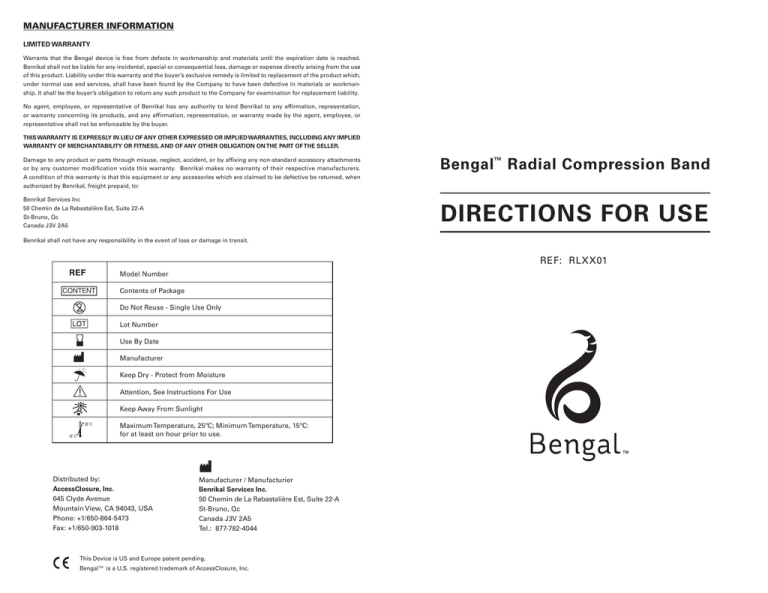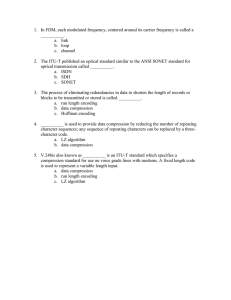IFU Bengal
advertisement

MANUFACTURER INFORMATION LIMITED WARRANTY Warrants that the Bengal device is free from defects in workmanship and materials until the expiration date is reached. Benrikal shall not be liable for any incidental, special or consequential loss, damage or expense directly arising from the use of this product. Liability under this warranty and the buyer’s exclusive remedy is limited to replacement of the product which, under normal use and services, shall have been found by the Company to have been defective in materials or workmanship. It shall be the buyer’s obligation to return any such product to the Company for examination for replacement liability. No agent, employee, or representative of Benrikal has any authority to bind Benrikal to any affirmation, representation, or warranty concerning its products, and any affirmation, representation, or warranty made by the agent, employee, or representative shall not be enforceable by the buyer. THIS WARRANTY IS EXPRESSLY IN LIEU OF ANY OTHER EXPRESSED OR IMPLIED WARRANTIES, INCLUDING ANY IMPLIED WARRANTY OF MERCHANTABILITY OR FITNESS, AND OF ANY OTHER OBLIGATION ON THE PART OF THE SELLER. Damage to any product or parts through misuse, neglect, accident, or by affixing any non-standard accessory attachments or by any customer modification voids this warranty. Benrikal makes no warranty of their respective manufacturers. A condition of this warranty is that this equipment or any accessories which are claimed to be defective be returned, when authorized by Benrikal, freight prepaid, to: Benrikal Services Inc 50 Chemin de La Rabastalière Est, Suite 22-A St-Bruno, Qc Canada J3V 2A5 Bengal™ Radial Compression Band DIRECTIONS FOR USE Benrikal shall not have any responsibility in the event of loss or damage in transit. REF: RLXX01 Model Number CONTENT Contents of Package Do Not Reuse - Single Use Only Lot Number Use By Date Manufacturer Keep Dry - Protect from Moisture Attention, See Instructions For Use Keep Away From Sunlight Maximum Temperature, 25ºC; Minimum Temperature, 15ºC: for at least on hour prior to use. Distributed by: AccessClosure, Inc. 645 Clyde Avenue Mountain View, CA 94043, USA Phone: +1/650-864-5473 Fax: +1/650-903-1018 Manufacturer / Manufacturier Benrikal Services Inc. 50 Chemin de La Rabastalière Est, Suite 22-A St-Bruno, Qc Canada J3V 2A5 Tel.: 877-782-4044 This Device is US and Europe patent pending. Bengal™ is a U.S. registered trademark of AccessClosure, Inc. CAUTION s s s s s Health Canada and FDA (USA) restrict this device to use by or on the order of a physician. This device is provided non-sterile. Store in a cool, dry place. Store between 15ºC – 25ºC for at least one hour prior to use. Single use only. Disposal in bio-medical waste system only. s Engage the bracelet into the micro-adjustment fastener with thumb on compression pad, and tighten enough to keep band in place. [See Figures 2a, 2b] DEVICE DESCRIPTION INDICATION FOR USE: The Bengal Radial Compression band will assist in obtaining and maintaining hemostasis of the radial artery following a transradial catheterization procedure. Bengal is a single use disposable device. s Latex free. s A transparent soft polymer cylinder that provides selective compression to the puncture site. s Polypropylene transparent bracelet with a micro-adjustable fastening system. s A clear soft polymer transparent pad to reduce pressure on dorsal side of the wrist. s A non-adhesive sterile dressing is included in the package. PRECAUTIONS Figure 2a Figure 2b s Holding the compression pad with the thumb, remove the procedural sheath with opposite hand. s Tighten with firm pressure by placing thumb in the cavity of the compression pad and pulling on the strap. s Observe that the desired pressure is achieved and maintained. ADJUST THE DEVICE TO ENSURE NON-OCCLUSIVE COMPRESSION s Maintain device at firm pressure for five to ten minutes prior to testing for non-occlusive compression. s Non-occlusive pressure creates partial blood flow, allowing platelets to create hemostasis. Hemostasis will be achieved through equilibrium of intravascular and extravascular pressure. s Perform reverse Allen’s test: Verify radial patency during compression by occluding the ulnar artery and using an oximeter at the thumb. [See Figure 3] Hemostasis could take longer in patients with the following: s Platelets < 250,000 units s Systolic blood pressure > 160 mmHg s Patients currently receiving Coumadin or GPIIb/IIIa DIRECTIONS FOR USE APPLYING THE DEVICE s Before applying Bengal to the patient, make sure skin is clean and dry. s Place the sterile non-adhesive dressing (included with device) over the puncture site/sheath. s Place the soft cylinder compression pad and adaptor: Use thumb to align the soft pad over the puncture site. s To achieve the appropriate compression, place the cylinder compression pad at a 90 degree angle to the skin surface. s If the adaptor is used (default approach), align the device according to these markers [See Figure 1a]: - Attach the adaptor to the receiver before placing the device over the puncture site, ensuring that the two pieces are securely joined. - Point the arrow on the adaptor towards the hand, ensuring the smaller part of the adaptor is closer to the hand. - Align the puncture site with the T junction on the distal portion of the adaptor, just next to the cylinder compression pad. - Ensure the adaptor is placed proximal to the wrist bone, not over the wrist bone s If the adaptor is not used (small wrists or access sites close to the wrist crease), align the device according to these markers [See Figure 1b]: - Align the puncture site directly underneath the cylinder compression pad. Figure 3 s Mark bracelet under the zip tie locking system with a pen to record the initial compression point s Adjust pressure if necessary by releasing one notch and re-assessing radial patency until achieving 95% oxygen saturation or a waveform. REMOVING THE BENGAL s It is recommended that you follow established holding times at your facility. s Assure hemostasis at the access site has been achieved. Ask patient to move fingers and assess access site. s Remove device one notch at a time, observing for hemostasis at each notch for desired holding time, until device is loosened. If bleeding is observed, re-tighten the device to original mark. s If no bleeding or oozing occurs, dry the puncture site and place a sterile transparent dressing. s Prior to discharge, apply sterile dressing per hospital protocol. s Note: If any oozing occurs, apply a compression bandage to accelerate hemostasis. s If bleeding, reassess radial patency using the oximetry technique and leave bracelet on for another hour. PATIENT CARE INFORMATION Figure 1a Figure 1b s s s s Patient should not immerse wrist in water for the first 24 hours post procedure. Patient should not lift any excessive weight for the first 24 hours post procedure. Patient should not use spa or sauna for the first 24 hours post procedure. Please refer patient to any other discharge orders on the order of the physician.



